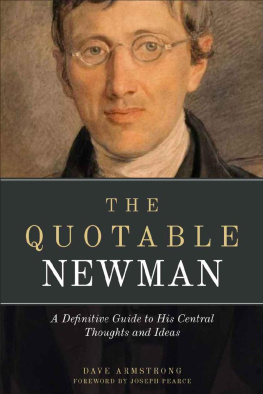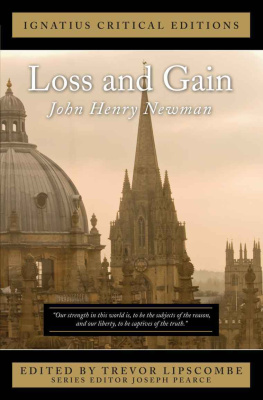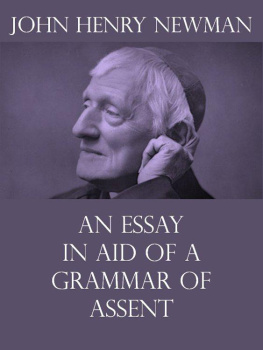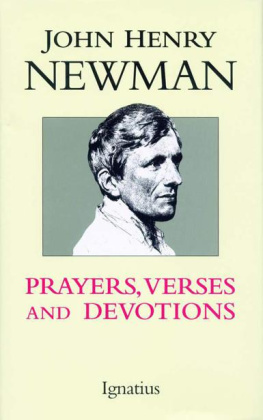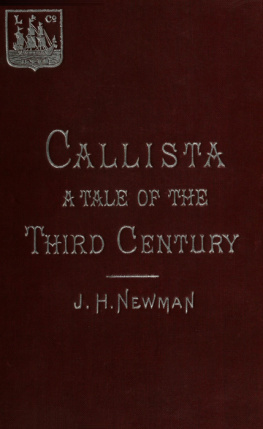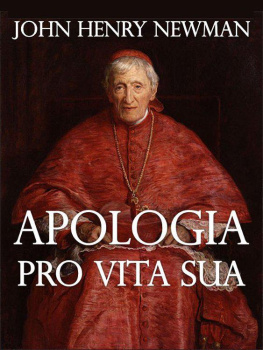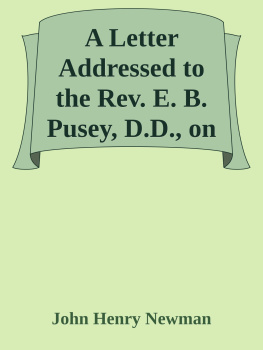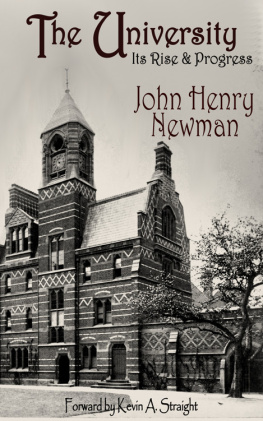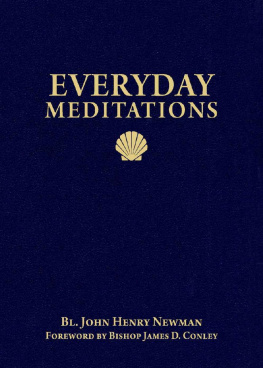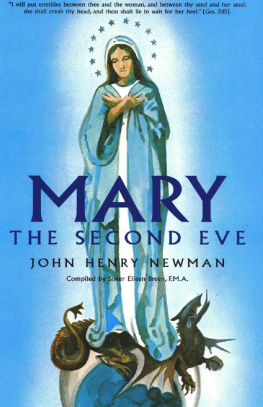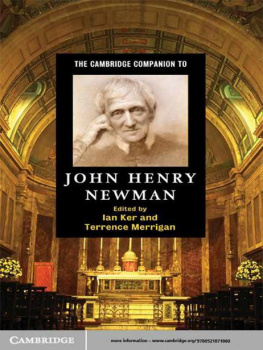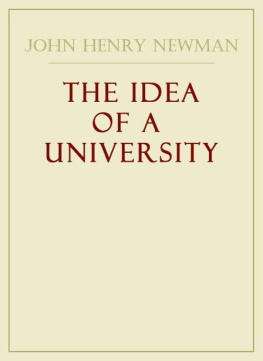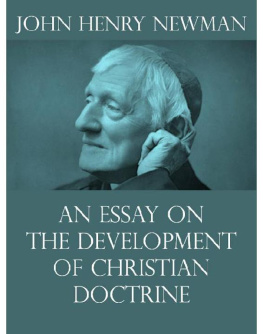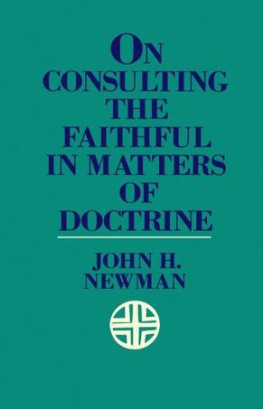John Henry Newman - The Quotable Newman: A Definitive Guide to John Henry Newmans Central Thoughts and Ideas
Here you can read online John Henry Newman - The Quotable Newman: A Definitive Guide to John Henry Newmans Central Thoughts and Ideas full text of the book (entire story) in english for free. Download pdf and epub, get meaning, cover and reviews about this ebook. year: 2012, publisher: Sophia Institute Press, genre: Religion. Description of the work, (preface) as well as reviews are available. Best literature library LitArk.com created for fans of good reading and offers a wide selection of genres:
Romance novel
Science fiction
Adventure
Detective
Science
History
Home and family
Prose
Art
Politics
Computer
Non-fiction
Religion
Business
Children
Humor
Choose a favorite category and find really read worthwhile books. Enjoy immersion in the world of imagination, feel the emotions of the characters or learn something new for yourself, make an fascinating discovery.
- Book:The Quotable Newman: A Definitive Guide to John Henry Newmans Central Thoughts and Ideas
- Author:
- Publisher:Sophia Institute Press
- Genre:
- Year:2012
- Rating:5 / 5
- Favourites:Add to favourites
- Your mark:
- 100
- 1
- 2
- 3
- 4
- 5
The Quotable Newman: A Definitive Guide to John Henry Newmans Central Thoughts and Ideas: summary, description and annotation
We offer to read an annotation, description, summary or preface (depends on what the author of the book "The Quotable Newman: A Definitive Guide to John Henry Newmans Central Thoughts and Ideas" wrote himself). If you haven't found the necessary information about the book — write in the comments, we will try to find it.
John Henry Newman: author's other books
Who wrote The Quotable Newman: A Definitive Guide to John Henry Newmans Central Thoughts and Ideas? Find out the surname, the name of the author of the book and a list of all author's works by series.
The Quotable Newman: A Definitive Guide to John Henry Newmans Central Thoughts and Ideas — read online for free the complete book (whole text) full work
Below is the text of the book, divided by pages. System saving the place of the last page read, allows you to conveniently read the book "The Quotable Newman: A Definitive Guide to John Henry Newmans Central Thoughts and Ideas" online for free, without having to search again every time where you left off. Put a bookmark, and you can go to the page where you finished reading at any time.
Font size:
Interval:
Bookmark:
Dave Armstrong
The Quotable Newman
A Definitive Guide to His
Central Thoughts and Ideas
SOPHIA INSTITUTE PRESS
Manchester, New Hampshire
Other books by Dave Armstrong
from Sophia Institute Press:
The Catholic Verses
The One-Minute Apologist
Bible Proofs for Catholic Truths
A Biblical Defense of Catholicism
For related reading on the authors blog,
see my topical index web page:
Blessed John Henry Cardinal Newman:
The Father of the Second Vatican Council
http://socrates58.blogspot.com/2006/04/
venerable-john-henry-cardinal-newman.html
Copyright 2012 Dave Armstrong
Printed in the United States of America
All rights reserved
Cover design by Carolyn McKinney
On the cover: Portrait of Newman by Sir William Ross, used by kind
permission of the Warden and Fellows of Keble College, Oxford.
Sophia Institute would like to offer a special thanks Dr. Philip T. Crotty
for helping to make possible the publication of The Quotable Newman.
No part of this book may be reproduced, stored in a retrieval system,
or transmitted in any form, or by any means, electronic, mechanical,
photocopying, or otherwise, without the prior written permission of the
publisher, except by a reviewer, who may quote brief passages in a review.
Sophia Institute Press
Box 5284, Manchester, NH 03108
1-800-888-9344
www.SophiaInstitute.com
Sophia Institute Press is a registered trademark of Sophia Institute.
thoughts and ideas / [edited by] Dave Armstrong. p. cm. Includes bibliographical references. ISBN 978-1-933184-84-5 (pbk. : alk. paper)
978-1-622821-12-9 (eBook) 1. Newman, John Henry,
1801-1890 Quotations. I. Armstrong, Dave, 1958- II. Title. BX4705.N5A25 2012 dc23 2012010873
Contents
Preface
by Joseph Pearce
In 2010, I was honored to be among the official press commentators for Pope Benedict XVIs visit to Britain. It was indeed a joy and a privilege to follow the Pope as he visited venues in London that resonated with Catholic significance. He visited Westminster Hall, in which St. Thomas More had stood trial, and visited Westminster Abbey to pray at the shrine of St. Edward the Confessor. He blessed the crowds in Hyde Park, only a stones throw from the site of Tyburn Tree, the Machiavellian altar on which numerous Catholic martyrs were slain. It was as though the places selected for the Popes visit had been carefully chosen to remind Englishmen of their Catholic heritage and to warn of the dangers inherent in secularist intolerance toward the Church. The purpose of the Popes visit, however, was not primarily to celebrate Englands Catholic heritage but to beatify John Henry Newman. In so doing, the Pope was not so much celebrating history as making it. Newman was the first Englishman, other than the martyrs, to be beatified since the Reformation; he was also the first Englishman born since the seventeenth century to be raised to the altar.
John Henry Newman was born in 1801, at the very dawn of the nineteenth century, and lived until 1890, as the sun began to set on this most catalytic and cataclysmic of epochs. During Newmans long and eventful life, new ideas would cause seismic shifts in the way modern man perceived himself. Karl Marx adapted the ideas of Hegel in the service of revolutionary politics, thereby unleashing an ideology that would claim the lives of tens of millions of people in the following century. Charles Darwin proposed the evolution of species from primitive beginnings, thereby initiating the notion of biological progressivism and the chronological snobbery that is its consequence. Friedrich Nietzsche declared brazenly that God was dead, thereby deifying man. Sigmund Freud supplanted the conscious will with subconscious complexes, thereby supplanting rational moral choices with irrational psychological urges. Revolutions swept across Europe as nationalism and socialism threatened the old order, sowing the seeds of National Socialism and its international communist Big Brother. The British Empire swept across the world, laying the foundations of globalism. It was a time of change and uncertainty and yet, at the same time and as the life of Newman testifies, it was also a time of religious revival and resurgent traditionalism.
Newmans own place within the Catholic Revival is paramount. He is indeed the very Father of the Revival itself.
At the time of Newmans birth, the Catholic Church in England had been largely rooted out of the national life and consciousness. Between the 1530s and the 1680s countless Catholics had been put to death for their faith. There are more than a hundred canonized and beatified English martyrs and many others whose final sacrifice for the Faith has not been officially recognized by the Church. In the wake of the so-called Glorious Revolution of 1688, which deposed the Catholic monarch, James II, two Jacobite uprisings sought the return of the true kings heirs to the throne. In the second of these uprisings the followers of Bonnie Prince Charlie were finally defeated at the Battle of Culloden in 1746, crushing any realistic hope of the return of a Catholic monarchy. At this point, after more than two hundred years of relentless persecution, all seemed lost for Englands shrinking Catholic population. A small number of recusant families, who had clung to the Faith doggedly and dogmatically in defiance of the ongoing war of attrition against them, had resigned themselves to a place on the margins of English life, excluded from preferment in politics and society by the ingrained and institutionalized prejudice of their fellow countrymen. This was the world in which Newman was born and in which he was due to play a major role.
Newmans conversion in 1845, sixteen years after Catholic Emancipation and five years before the reestablishment of the Catholic hierarchy in England, heralded the birth of a revival that would see the resurrection of the Faith in the English-speaking world. Prior to Newmans conversion, Catholicism had been perceived by the British as a foreign religion, espoused by swarthy and superstitious Mediterranean types. As the power of Britain waxed into the fullness of an empire and as the power of Italy, Spain, and Portugal waned into relative impotence, it was easy for the British to feel superior and supercilious. Catholicism was a primitive and backward religion for primitive and backward people. Such snobbery was thrown into confusion by Newmans reception into the Catholic Church. It was difficult to dismiss the submission of such an intellectual giant to the historical and dogmatic claims of Rome.
Newman had made an intensive study of the early Church and had concluded that the Faith of the Church Fathers was the same holy, catholic, and apostolic Faith as that preached and taught by the Catholic Church of his own day. Newmans scholarship and his eloquence in expressing it shook the Anglican establishment, throwing into question the presumptions and prejudices on which the foundation of the Church of England was built.
A wave of converts from the higher echelons of society crossed the Tiber in Newmans wake as conversion became almost fashionable. At the same time, a huge influx of Irish immigrants, fleeing the potato famine, greatly increased the number of working-class Catholics. Almost overnight, Catholicism was becoming a significant force in British society, the presence of a growing number of erudite converts coinciding with the growing plebian presence of the Irish immigrants. The result would be a Catholic revival that would last for more than a century.
The first period of this revival could be called the Newman period, stretching from the great mans conversion in 1845 until his death in 1890. The second period, or what might be called the decadent interlude, spanned the final decade of the century in which the writers and artists of the fin de sicle flirted with Rome and ultimately succumbed to the charms of the Church. Among the converts from this decade were Oscar Wilde, Aubrey Beardsley, Ernest Dowson, and Lionel Johnson. The next major span of the revival could be called the Chesterbelloc period, in which the giant figures of G. K. Chesterton and Hilaire Belloc loomed large, which spanned from 1900, the year in which Chesterton was first published, until 1936, the year of his death. The final stage could be called the Inklings period, during which the figures of J.R.R. Tolkien and C. S. Lewis dominated, spanning from 1937, the year The Hobbit was published, until 1973, the year of Tolkiens death.
Next pageFont size:
Interval:
Bookmark:
Similar books «The Quotable Newman: A Definitive Guide to John Henry Newmans Central Thoughts and Ideas»
Look at similar books to The Quotable Newman: A Definitive Guide to John Henry Newmans Central Thoughts and Ideas. We have selected literature similar in name and meaning in the hope of providing readers with more options to find new, interesting, not yet read works.
Discussion, reviews of the book The Quotable Newman: A Definitive Guide to John Henry Newmans Central Thoughts and Ideas and just readers' own opinions. Leave your comments, write what you think about the work, its meaning or the main characters. Specify what exactly you liked and what you didn't like, and why you think so.

